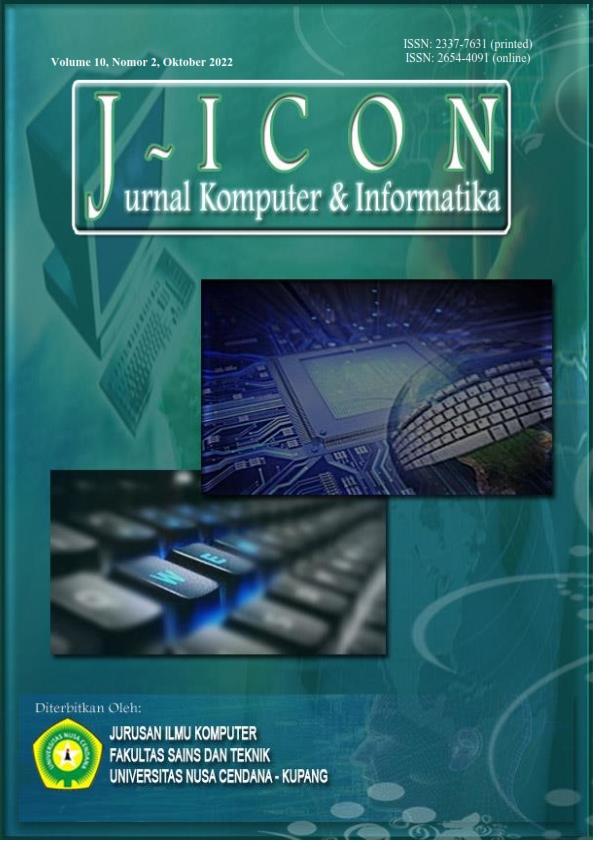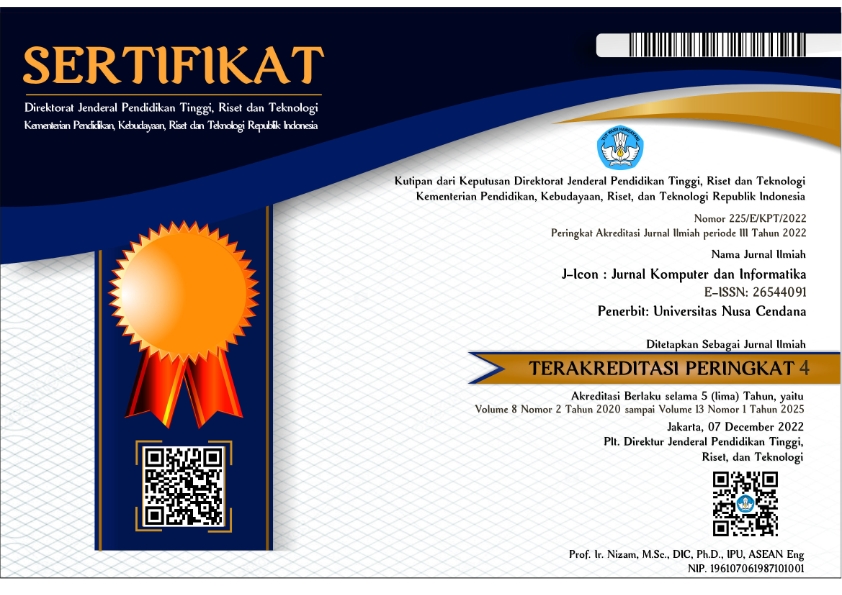ACCOUNTING INFORMATION SYSTEM AT MADRASAH TSANAWIYAH AL-IKHLAS SOE DISTRICT TTS PROVINCE NTT
Abstract
School financial accounting activities are one of the important activities in every educational institution. The Madrasah Tsanawiyah (MTs) Al-Ikhlas Soe, TTS district, NTT province also carried out this activity but it was still done manually which had to be recorded every time a financial accounting transaction was carried out. Therefore, the researchers designed and built a web that aims to enable schools to record accounting transactions through a computerized system which then produces accounting data reports for student tuition payments, school enrollment payments, honorary teacher salaries and school financial cash flows. The method used is the software development life cycle (SDLC) method, which is one method with a characteristic where each phase of work is carried out must be done first before proceeding to phase next, thus the results will focus on each phase so that the work is carried out optimally because there is no parallel work. This study uses two tests of the system, namely blackbox which focuses on testing the functional specifications of the system software, and testing questionnaires to get responses or answers from respondents, namely teachers from MTs Al-Ikhlas Soe regarding the system that has been created. With these two tests, this application system gets a 100% test score percentage using blackbox this is because the functionality of the software runs as expected and also gets an average percentage test value of 83% or 80% using questionnaire testing.
Downloads
References
E. D. Susanti, “Sistem Informasi Administrasi Keuangan Sekolah Berbasis Web di SMK YP 17 Selorejo-Blitar,” J-INTECH, vol. 5, no. 01, pp. 53–58, 2017.
F. Mufidah and M. M. Jannah, “EFEKTIVITAS SISTEM INFORMASI AKUNTANSI PADA SISTEM PEMBAYARAN SPP DI PONDOK PESANTREN LA TANSA,” JURNAL STUDIA AKUNTANSI DAN BISNIS, vol. 5, no. 2, Aug. 2017, Accessed: Aug. 20, 2021. [Online]. Available: https://jurnalstie.latansamashiro.ac.id/index.php/JSAB/article/view/83
U. Udi, “Penerapan Metode SDLC Waterfall Dalam Pembuatan Sistem Informasi Akademik Berbasis Web Studi Kasus Pondok Pesantren Al-Habib Sholeh Kabupaten Kubu Raya, Kalimantan Barat,” Jurnal Teknologi Dan Manajemen Informatika, vol. 4, no. 1, 2017.
S. P. Arifin, “Implementasi Sistem Informasi Akuntansi Berbasis Website pada Sekolah Insan Teladan Pekanbaru,” ABEC Indonesia, vol. 9, pp. 49–56, 2021.
M. Mursyidah and H. T. Hidayat, “Pengujian Sistem Informasi Akuntansi Biaya Operasional Sekolah Dengan Black Box Testing,” Jurnal Infomedia: Teknik Informatika, Multimedia & Jaringan, vol. 2, no. 2, 2017.
W. Nugraha, M. Syarif, and W. S. Dharmawan, “Penerapan Metode SDLC Waterfall dalam Sistem Informasi Inventori Barang Berbasis Desktop,” JUSIM (Jurnal Sistem Informasi Musirawas), vol. 3, no. 01, pp. 23–29, 2018.
Wijaya and E. Susanto, “New Normal: Pengembangan Sistem Informasi Penjualan Menggunakan Metode SDLC (System Development Life Cycle),” Jurnal Sustainable: Jurnal Hasil Penelitian dan Industri Terapan, vol. 10, no. 1, pp. 1–9, 2021.
E. T. Rahmawati, S. Subagyo, and D. Budiadi, “Implementasi Penggunaan sistem Informasi Akuntansi UMKM dalam Menghadapi Revolusi Industri 4.0,” Cahaya Aktiva, vol. 9, no. 2, pp. 159–174, 2019.
R. DEWI, “ANALISIS SISTEM INFORMASI AKUNTANSI DALAM PENERIMAAN DAN PENGELUARAN KAS PADA DANA BANTUAN OPERASIONAL SEKOLAH (BOS) SEBAGAI ALAT PENGENDALIAN INTERNAL (STUDI KASUS PADA SDN 012 TANJUNG GADAI KECAMATAN TEBING TINGGI TIMUR KABUPATEN KEPULAUAN MERANTI),” PhD Thesis, Universitas Islam Negeri Sultan Syarif Kasim Riau, 2020.
T. Hidayat and M. Muttaqin, “Pengujian Sistem Informasi Pendaftaran dan Pembayaran Wisuda Online menggunakan Black Box Testing dengan Metode Equivalence Partitioning dan Boundary Value Analysis,” Jutis (Jurnal Teknik Informatika), vol. 6, no. 1, Art. no. 1, Feb. 2020, doi: 10.33592/jutis.Vol6.Iss1.38.
M. S. Jaya, P. Gumilang, T. Wati, Y. P. Andersen, and T. Desyani, “Pengujian Black Box pada Aplikasi Sistem Penunjang Keputusan Seleksi Calon Pegawai Negeri Sipil Menggunakan Teknik Equivalence Partitions,” Jurnal Informatika Universitas Pamulang, vol. 4, no. 4, pp. 131–136, 2019.
K. N. Cahyo, M. Martini, and E. Riana, “Perancangan Sistem Informasi Pengelolaan Kuesioner Pelatihan Pada PT Brainmatics Cipta Informatika,” Journal of Information System Research (JOSH), vol. 1, no. 1, pp. 45–53, 2019.
M. Maryuliana, I. M. I. Subroto, and S. F. C. Haviana, “Sistem Informasi Angket Pengukuran Skala Kebutuhan Materi Pembelajaran Tambahan Sebagai Pendukung Pengambilan Keputusan Di Sekolah Menengah Atas Menggunakan Skala Likert,” TRANSISTOR Elektro dan Informatika, vol. 1, no. 1, Art. no. 1, Oct. 2016, doi: 10.30659/ei.1.1.1-12.
E. S. Rahman and D. Vitalocca, “Analisis Usabilitas Menggunakan Use Questionnaire Pada Sistem Informasi Smk Negeri 3 Makassar,” Jurnal Mekom, vol. 5, no. 1, pp. 16–22, 2018.
Copyright (c) 2022 utia Lestari, Emerensye S Y Pandie, Bertha S Djahi

This work is licensed under a Creative Commons Attribution 4.0 International License.
The author submitting the manuscript must understand and agree that if accepted for publication, authors retain copyright and grant the journal right of first publication with the work simultaneously licensed under a Creative Commons Attribution (CC-BY) 4.0 License that allows others to share the work with an acknowledgment of the work’s authorship and initial publication in this journal.
 Mutia Lestari(1*)
Mutia Lestari(1*)




